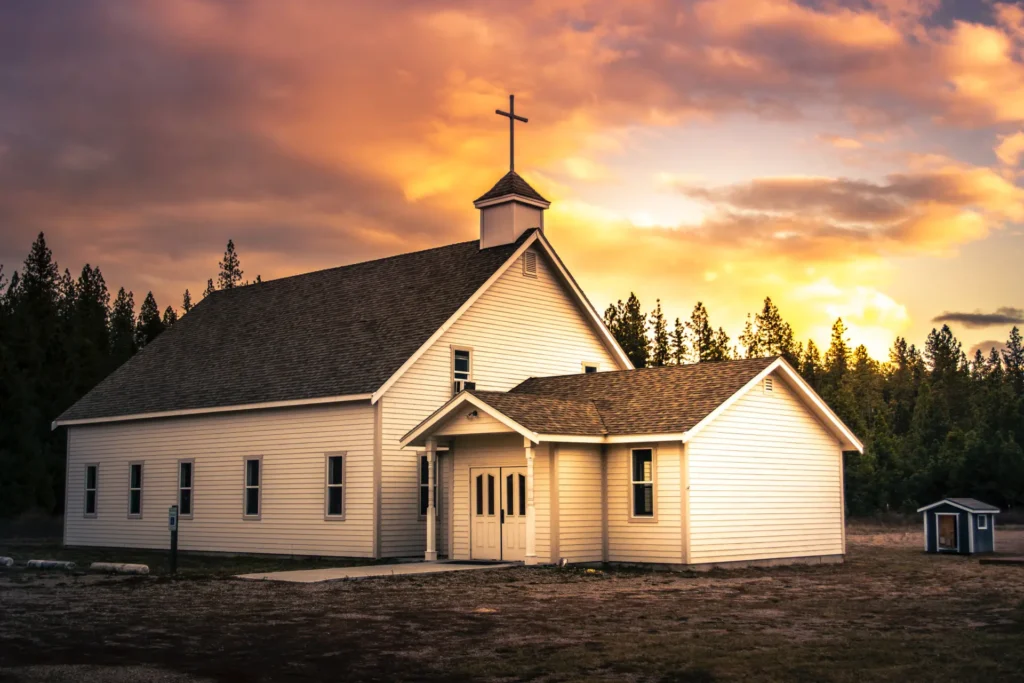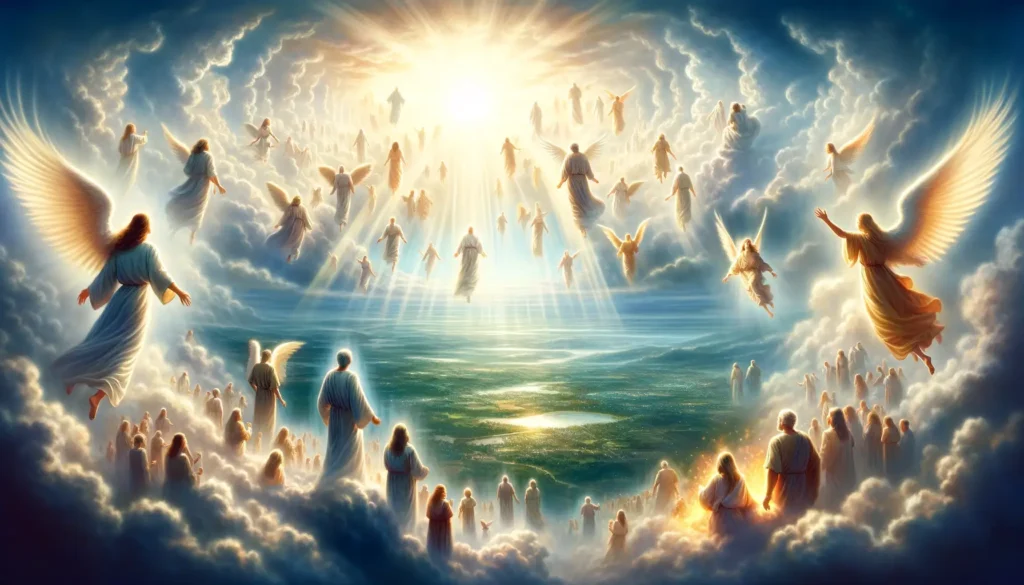Understanding the Church during End Times
The Rapture, a topic of intrigue and debate, often sparks curiosity and questions. It’s a subject that has captured the imagination of many, both within and outside religious circles. The concept has been hyped in both circles, but is widely misunderstood.
What is the Rapture? It is a concept most commonly associated with conservative branches of Christianity, particularly Evangelical and Fundamentalist branches. It was popularized by Hall Lindsay in the 70’s and later by Jerry Jenkins and Tim Lehaye in the Left Behind book series. The term “Rapture” doesn’t actually appear in the Bible. It comes from the Latin word “rapturo,” which is used in the Latin Vulgate to translate the Greek word “harpazo” in 1 Thessalonians 4:17. This Greek word can be translated as “caught up” or “taken away”. Paul tells us in this passage that those who are saved will one day be taken out of this earth. But how, why and when?
To understand the Rapture, we first must understand the events that it is intended to accomplish. As explained by Paul the Rapture is an event that satisfies several of God’s purposes in His plan. It encompasses unification of the saved with Christ, resurrection and transformation of believers into their heavenly bodies, and deliverance from coming judgment. It represents the culmination of the salvation narrative, where the promises of eternal life, resurrection, and transformation find their fulfillment.
The Coming Judgement and the Rapture
As we saw the Rapture provides deliverance from the coming judgement. Just what does that mean? At the end of the age God has determined that judgement will be poured out. This is Great Tribulation, which represents a period of divine judgment and suffering unparalleled in human history. This period is characterized by God’s wrath, a concept deeply rooted in biblical teachings. The wrath of God, or “Indignation” (Hebrew: Za`am), is depicted not merely as anger but as a righteous response to sin and rebellion against His divine authority. This is exemplified in scriptural passages such as Daniel 8:18-19 and Daniel 11:36-37, which describe visions of the end times and God’s decisive action against wickedness. God’s coming judgement.
In the New Testament, the Greek term “orge” is used to describe this wrath, echoing the Old Testament’s portrayal. This wrath serves as both a punishment for sin and a testament to God’s holiness. The Tribulation is thus seen as the fulfillment of this divine wrath, aligning with biblical prophecies. The Tribulation serves dual purposes:
- it is a time for the salvation of Israel, as indicated in Jeremiah 30:7 and Daniel 12:1, suggesting a period critical for Israel’s spiritual awakening and national restoration.
- it is a time for the judgment of the ungodly, as indicated in Hosea 5:15, which speaks of God withdrawing His presence, prompting repentance.
The judgement of God that will be upon on the world during the Tribulation will be unlike anything ever experienced before. God has judged the people several times as we know – in the time of Noah He flooded the world to cleanse it of unrighteousness. In the time after the flood when the people built a tower to the heavens, He once again judged the people by confusing their languages. The judgement coming will far greater than any before.

The Great Tribulation is God’s righteous indignation against sin. It signifies both the judgment of the ungodly and the working out of the redemptive purpose for Israel, fulfilling ancient prophecies and setting the stage for the ultimate establishment of God’s kingdom. The focus of this period is the ungodly and the Jewish people. This period has nothing to do with the Church. We find that after chapter 3 of Revelations the church is not mentioned until after the judgements against the ungodly have concluded.
So where is the Church?
During this period the Church is not here on earth! How can we be sure the church is not present during the tribulation? The concept that the church will not be present during the Tribulation is grounded in various scriptural interpretations. A key aspect of this conviction is the idea of deliverance from wrath, as stated in 1 Thessalonians 1:9-10:
This scripture speaks of believers being rescued from the impending wrath, suggesting a removal from, rather than endurance through, such trials. This idea is further reinforced in 1 Thessalonians 5:9-10, where it’s declared that believers are not destined for wrath but for obtaining salvation through Jesus Christ. This passage is often viewed as an assurance that the church will not experience the Tribulation.

The teachings of Jesus in John 14:1-3 about preparing a place in heaven for His followers and returning to take them there is seen as a pre-Tribulation promise. This passage implies that believers will be taken to heaven, thereby avoiding the tribulation on earth. Similarly, we a promise of protection from the “hour of trial” that will come upon the world in Revelation 3:10:
This is interpreted as an indication of the church being removed before the tribulation, which is primarily a time of testing for those on earth.
The scene in Revelation 4:1, where John hears a trumpet and is called up to heaven, is correlated with the rapture of the church. This event, occurring before the visions of the tribulation, is seen as an indication that the church will be taken to heaven prior to the tribulation’s onset. That trumpet that John witnessed is thought to be the “last trumpet” mentioned in 1 Corinthians 15:51-52:
Here we see the trumpet signaling the resurrection and transformation of believers, is viewed as distinct from the trumpet judgments in Revelation, further supporting the idea of a pre-Tribulation rapture.
The sequence of end-times events suggests that the “man of lawlessness” (the Antichrist) will be revealed only after the removal of what restrains him as read in 2 Thessalonians 2:7-8:
The one who holds back the power of lawlessness is the Holy Spirit, which is resident in every believer. Satan will have free reign of the earth once the Holy Spirit is removed from the earth, but for that to happen the Church will need to be removed as well. These verses tell us the Antichrist will not appear before the Church has been removed as it is part of the restraining force Paul speaks of.
These scriptural references collectively support the interpretation that the church will be raptured or taken to heaven before the Tribulation. This belief is grounded in the thematic consistency of deliverance, protection, and divine promise evident in God’s word.
This brings us to the Rapture
If the church is not present during the judgement that God pours out on the earth during the tribulation, then what has happened to the church? Paul tells us that it is taken up into heaven – in other words Raptured!. We find this in 1 Thessalonians 4:16-17 (New International Version):
We can have confidence that this verse describes a literal event where believers are physically caught up into the sky to meet Jesus. Paul does not call this a Rapture and in fact the Bible doesn’t mention the term Rapture by name at all – as mentioned earlier. Instead, it comes from the Latin which the Bible had been translated into in the fourth century. The word that was used was “rapturo,” which is translated the Greek word “harpazo” which Paul penned in 1 Thessalonians 4:17. This Greek word can be translated as “caught up” or “taken away”. As a result we get our English term Rapture from these ideas.
Another common scriptural reference to the Rapture also comes from Paul and can be found in 1 Corinthians 15:52 (New International Version):
Here once again, the transformative event that Paul refers to is the Rapture. The majority of teachers who prescribe to the inerrant Word of God do not dispute that there will be an event where believers in Christ will be taken up to meet Jesus. There is significant difference in interpretation among scholars as to when the event will occur in regard to the Tribulation taught about in Revelations and Daniel.
The belief in a pre-Tribulation Rapture posits that this event will occur before the seven-year Tribulation period, effectively sparing true Christians from that time of suffering and removing his Holy Spirit from the earth to allow Satan free reign over the earth. Traditionally this belief has been based on a dispensationalist interpretation of Scripture, which divides history into distinct periods or “dispensations,” and is largely derived from a literal interpretation of prophetic Scriptures, particularly from the books of Daniel and Revelation.
The opposing view posits a Resurrection at the Second Coming of Christ either at the end of the Tribulation or the Millennium. This belief holds that the “catching up” refers to the resurrection of the dead and the transformation of the living at the Second Coming of Christ. In this view there is no separate “rapture” event distinct from the Second Coming.

The primary scriptural support comes from a reading of 1 Thessalonians 4:16-17 and 1 Corinthians 15:51-52 in their broader context, as part of descriptions of the resurrection of the dead and the return of Christ. Supporters point to verses like Matthew 24:30-31, where the gathering of the elect occurs at the same time as the visible return of Christ. They argue that the New Testament consistently talks about believers being resurrected or transformed at the “last day” (John 6:39-40, John 11:24) or “last trumpet” (1 Corinthians 15:52), which they understand to refer to the Second Coming.
They also often argue that the concept of a pre-tribulation rapture is absent from the historical Church until the 19th century, suggesting that it’s a recent innovation rather than a part of the original Christian understanding.
The Timing of the Rapture Matters
There is tension between competing views as to when the Rapture might occur among teachers and scholars who have arrived at the conclusion that a Rapture is probable. Suggested timing as we saw above is before the tribulation begins, often called a Pre-Trib Rapture, at the end of the tribulation and aligning with the second coming of Christ as well as the minority view of in the middle of the tribulation. Obviously only one of these can be right. We believe that with careful study of God’s word we can know the truth. Ultimately the timing of the rapture matters as it will affect how we choose to spread the Kingdom message as well as how we will choose to live.
In preparing this article I had three objectives. One is to present a clear and compelling argument for a Pre-Tribulation view of the Rapture. This view is reflected in some of the material that we have already covered. Let us look that these points again as we seek support for this viewpoint.
Deliverance From Wrath
God is not calling on His church to suffer through His judgement on the earth, rather he plans for its deliverance from wrath, as stated in 1 Thessalonians 1:9-10:
It is clear from this scripture that believers are being rescued from the impending wrath. This informs our understanding of the Rapture as a removal from wrath. The opposing view would require the saints endurance through wrath, which does not appear to be biblical.
Protection from the Hour of Trial
God gives us a promise of protection from the “hour of trial” that will come upon the world in Revelation 3:10:
The hour of trial is clearly the final judgement against the nations as described in Revelations. If He is to keep us from this time, He will need to keep us some place besides the earth which is being judged.
The Purpose of the Judgement
The Great Tribulation is God’s righteous judgement against sin and a sinful world. It will be for both the judgment of the ungodly and the working out of the salvation of God’s people Israel. As such is will fulfill ancient prophecies in Daniel and Ezekiel as well as the prophesies recorded by John in Revelation. Ultimately will set the stage for the establishment of God’s kingdom on earth. The focus of this period is the ungodly and the Jewish people. This period has nothing to do with the Church.
Examination of the times of the Gentiles
The concept of “the times of the Gentiles,” is important in understanding the eschatological framework within evangelical Christianity. This term originates from Luke 21:24:
This verse describing the sacking of Jerusalem introduces a distinct period in God’s redemptive timeline, characterized by the spiritual focus shifting from Israel to the Gentile (non-Jewish) world. During this era God’s redemptive work is predominantly active among Gentile populations. This epoch is marked by the widespread dissemination of the Gospel and the exponential growth of the Christian church beyond the Jewish community.
Alongside this, the notion of “the fullness of the Gentiles,” as mentioned in Romans 11:25, plays a pivotal role:
This term suggests a divinely appointed time when a considerable number of Gentiles will embrace faith in Christ. It implies that God’s plan encompasses a specific, preordained quantity of Gentiles who will be integrated into His kingdom. This period is characterized by an extensive evangelical outreach and missionary endeavors among non-Jewish peoples, underpinning the ongoing nature of this prophetic phase.
These theological concepts have profound eschatological implications. The completion of “the fullness of the Gentiles” as aligning with key prophetic events, specifically the Rapture and will signifying the cessation of the Age of Grace.

The “Age of Grace” is a term used to describe the current dispensation, commencing with Christ’s crucifixion and resurrection, wherein salvation is accessible to all, irrespective of ethnic lineage, through faith in Jesus. This era is characterized by the extension of God’s grace, where the fulfillment of the law is realized through Christ, and salvation is not contingent on deeds but on faith (Ephesians 2:8-9). The “Age of Grace” correlates directly with the “Times of the Gentiles,” which leads us to the understanding that these concurrent periods that will culminate in the removal of the Holy Spirit and the revealing of the Antichrist. As we saw earlier the sequence of end-times events suggests that the “man of lawlessness” (the Antichrist) will be revealed only after the removal of what restrains him as read in 2 Thessalonians 2:7-8:
Imminence of Christ’s appearing
The concept of the imminence of Christ’s appearing is critical in Christian eschatology, particularly in the discussion of the timing of the Rapture. Imminence refers to the belief that Christ could return at any moment, without any specific prophesied events needing to occur first. This concept is based on passages like Matthew 24:36-44, which emphasize the unexpected nature of Christ’s return.
In a pre-tribulation Rapture scenario, the imminence of Christ’s return is maintained because there are no specific events that must occur before the Rapture. However, in mid or post-tribulation views, certain prophetic events (like the Tribulation itself) would need to happen first, thereby removing the element of imminence. If believers knew that Christ’s return was mid or post-tribulation, they would expect certain events to unfold before His coming, which would contradict the biblical teaching of His unexpected return, as highlighted in Matthew 24:36-44. This passage underlines the need for constant readiness and vigilance, as the exact time of Christ’s return is unknown.
When we consider all of these arguments above it is clear that scripture more than adequately support the concept of a pre-tribulation Rapture of the Church. So what does this mean to us as Christians? How should understanding that there will be a Rapture and it could occur at any time change the way we live?
Why Emphasize a Pre-Tribulation Rapture?
Emphasizing a pre-tribulation Rapture profoundly impacts Christian life and mindset. Firstly, it instills an urgency in evangelism. According to 2 Corinthians 6:2, which speaks of God’s favorable time and day of salvation, the imminent return of the Lord motivates believers to actively persuade others to Christ, recognizing the limited time for such outreach. This urgency is rooted in the understanding that the Rapture could occur at any moment, underscoring the immediacy of the Gospel message.
Additionally, the anticipation of the Rapture influences daily living and spiritual focus. Colossians 3:1-2 urges believers to set their hearts and minds on things above, not on earthly matters. This heavenly focus, shaped by the imminent return of Christ, encourages Christians to live lives that reflect eternal values and priorities, transcending the temporal nature of the world.

Moreover, the Rapture is seen as a source of hope and peace in a chaotic world. Titus 2:11-13 refers to the blessed hope and glorious appearing of Jesus Christ, inspiring believers to live righteously and godly in the present age. This hope provides a counterbalance to the turmoil of the world, offering a steadfast anchor in the promise of Christ’s return. The concept of imminent return also promotes holy living and a desire to fulfill one’s calling, as echoed in Romans 13:11-14, which speaks of waking from sleep and putting on the armor of light.
Lastly, the closing words of the Bible in Revelation 22:20, where Jesus says, “Surely I am coming quickly,” followed by the response, “Amen. Even so, come, Lord Jesus!” encapsulate the Christian anticipation and readiness for Christ’s return. This declaration reinforces the imminent nature of His coming and the believer’s eagerness for it.
In essence, the belief in a pre-tribulation Rapture not only fosters a sense of urgency in evangelism and a focus on heavenly things but also strengthens hope, peace, and the pursuit of holiness, as believers live in anticipation of Christ’s imminent return.
Conclusion
The Rapture, the belief where the church is taken out of the world before the pouring out of God’s judgment as described in Daniel and Revelation, is a cornerstone of Christian eschatological beliefs. It aligns with the idea of imminence, suggesting that Christ’s return for His church could happen at any moment, without the need for any specific prophetic events to precede it. This belief fosters a sense of urgency and readiness among believers, emphasizing the importance of living a life in accordance with Christian values, and being prepared for an unexpected moment of divine intervention.
Scripture reinforces the concept of the Rapture as a prelude to the Tribulation period, a time of great trial and judgment on earth. Passages like 1 Thessalonians 4:16-17 describe believers being caught up to meet the Lord in the air, which we believe decribes the church being removed before the Tribulation. This interpretation is seen as consistent with the theme of deliverance and grace that pervades the New Testament, suggesting that believers will be spared from the wrath to come, as echoed in 1 Thessalonians 1:10 and 5:9.
The pre-tribulation Rapture is viewed not only as a promise of deliverance from coming judgment but also as a call to faithful and vigilant living. It underscores the hope and peace that believers hold in Christ, serving as a reminder of God’s sovereignty and the fulfillment of His redemptive plan. The anticipation of the Rapture, therefore, influences the way believers approach their daily lives, underlining the importance of evangelism, holy living, and spiritual readiness in the face of an uncertain world.




